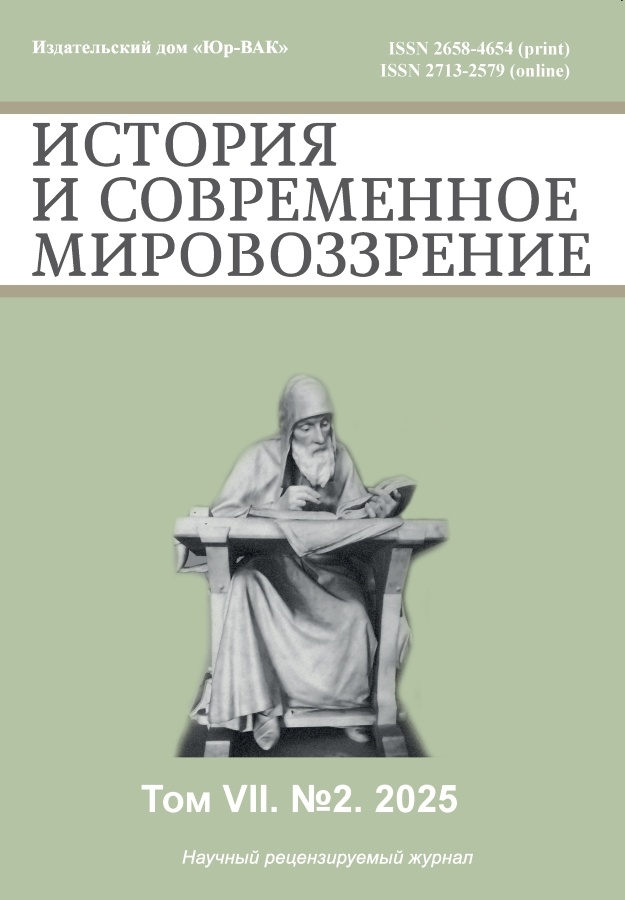Activities of Parochial Temperance Societies at the Churches of the Moscow Diocese in the Late 19th — Early 20th Centuries
- Authors: Enukov M.V.1
-
Affiliations:
- Russian State University for the Humanities
- Issue: Vol 7, No 2 (2025)
- Pages: 80-88
- Section: SOCIOCULTURAL COMMUNICATIONS IN THE PAST AND PRESENT
- URL: https://journals.eco-vector.com/2658-4654/article/view/688821
- DOI: https://doi.org/10.33693/2658-4654-2025-7-2-80-88
- EDN: https://elibrary.ru/qkpyns
- ID: 688821
Cite item
Abstract
In this article we will tell about the holy Russian new martyrs — patrons of sobriety. These saints in the late 19th and early 20th centuries waged a real fight against drunkenness, which in those turning points increasingly affected Russian society, leading to the savagery of man, the breakup of families, and orphanhood. The forms of the fight for sobriety were only developing and could be different — from traveling educational lectures to the creation of sobriety societies and material assistance to those who refused to drink, and their families. Libraries were often opened at these societies, especially needed in rural areas. They were very popular. Their book collections were replenished with both spiritual and secular literature, which could usefully occupy the readers' free time and strengthen them on the path of sober living. Public readings «with foggy pictures» were also organized, during which the teacher's or priest's story was accompanied by illustrations projected onto the wall. This form of presenting the material was in demand due to its greater clarity and the low literacy level of the population. Temperance societies organized teahouses, which were supposed to replace visits to drinking establishments. Unfortunately, after the revolution, due to persecution of the Russian Orthodox Church (Church), this activity was stopped. Many priests who led temperance societies suffered for their faith and are glorified in our time. Temples and monasteries where the new martyrs and confessors served — patrons of temperance — were closed, destroyed, but are now gradually being restored. Parishes are being revived and the sobriety service of the Church is coming to life, so familiarization with pre-revolutionary experience is acquiring special significance. Today, many methods and principles of our holy compatriots, fighters against drunkenness, are actively studied, disseminated and continue to be used in helping sufferers and their loved ones in parishes. The article provides information on the activities of the patrons of sobriety in Moscow and the Moscow province based on a study of sources, including archival materials, periodicals and works on local history.
Full Text
About the authors
Michael V. Enukov
Russian State University for the Humanities
Author for correspondence.
Email: tihvin.1680@mail.ru
ORCID iD: 0009-0003-7243-7068
SPIN-code: 9680-2510
Priest, postgraduate student
Russian Federation, MoscowReferences
- Afanasyev A.L. Temperance movement in Russia in 1907–1914: character, stages, significance. // Bulletin of Tomsk State University. History. 2014. No. 5(31). P. 27–32.
- Gusev G.V. Temperance societies as institutions of extracurricular additional education (late 19th — early 20th centuries) // Bulletin of PSTGU. Series IV: Pedagogy. Psychology. 2010. Issue 1 (16). P. 63–76.
- Kozlov V.F. Diocesan house in Moscow. Chronicle of the life of the House and the Prince Vladimir Church. Moscow, 2015. 716 p.
- Leontyeva T.G. Orthodox priests of pre-revolutionary Russia against the «stupid revelry of the tavern» // News of higher educational institutions. Volga region. Humanities: Scientific and practical journal 2007. No. 1. Pp. 3–10.
- Moshkin A.N. Educational activities of society and the Russian Orthodox Church to combat alcoholism among the population of Russia in the second half of the 19th — early 20th centuries // Historical, philosophical, political and legal sciences, cultural studies and art criticism. Theoretical and Practical Issues. 2013. No. 10 (36): in 2 parts. Part II. Pp. 131–134.
- Palamarchuk P.G. Forty forties. The Kremlin and monasteries. — M.: AO «Book and Business», AO «Krom», 1992. Vol. 1. 416 p.
- Palamarchuk P.G. Forty forties. Moscow within the boundaries of the Garden Ring: Kitay-gorod, Bely gorod, Zemlyanoy gorod, Zamoskvorechye. Moscow: AO Kniga i biznes, AO Krom, 1994. Vol. 2. 646 p.
- Palamarchuk P.G. Forty forties. Moscow within the boundaries of 1917. Moscow: AO Kniga i biznes, AO Krom, 1995. Vol. 3. 586 p.
Supplementary files



















